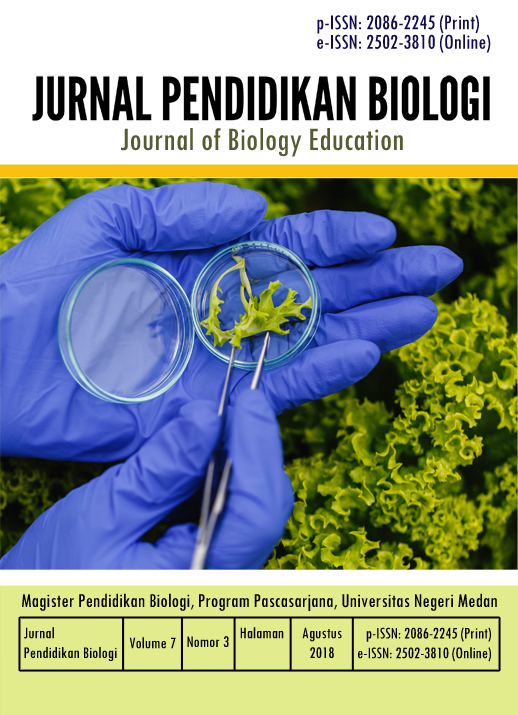Peningkatan Hasil Belajar Melalui Model Pembelajaran Inkuiri Laboratorium pada Materi Asam, Basa, dan Garam di Sekolah Menengah Pertama
DOI:
https://doi.org/10.24114/jpb.v7i3.10871Keywords:
Learning outcomes, Laboratory Inquiry, acids, bases, saltAbstract
The problem faced in this study is the low science learning outcomes in material related to chemistry. The purpose of this study was to determine the improvement of student learning outcomes through the Laboratory Inquiry learning model on acid, alkaline, and salt material in class VII of SMP 1 Percut Sei Tuan Tahun. Action research was conducted in class VII of SMP Negeri 1 Percut Sei Tuan with a total of 32 students. The research took place in 2 cycles by expressing four stages in each cycle, namely: the stages of planning, implementation, observation, and reflection. Analysis of research data in the form of quantitative and qualitative data which is the student learning outcomes (pre-test and post-test) and the results of observations of students' skills utilizing percentage, namely by calculating the increase in student mastery learning individually. The results of the first cycle test, there were 17 students (53.13%) had achieved mastery learning while 15 students (46.87%) had not achieved mastery learning. After it was found that there was an increase, it continued to give action in the second cycle. Then the results of the second cycle test were found to have a substantial increase in the number of students completing, namely from 32 students. It turned out that 28 students (87.50%) had achieved mastery learning, only four students (12.50%) had not reached completeness in learning. Students' skills in conducting practicum have increased significantly. Based on the results of the first cycle test and the second cycle test, it can be concluded that the Laboratory Inquiry Learning Model on Acid, Base, and Salt material can improve the learning outcomes of junior high school students.References
Joyce, B and Weil, M. (1972). Models of Teaching. Boston: Allyn and Bacon
Amin, M. (1987). Mengajarkan Ilmu Pengetahuan Alam (IPA) Dengan Menggunakan Metode œDiscovery dan œInquiry. Jakarta: Depdikbud Dirjen Dikti Proyek Pengembangan Lembaga Pendidikan Tenaga Kependidikan.
Arikunto, S. (1989) Dasar-dasar evaluasi Pendidikan Jakarta: Rineka Cipta
Cobern, William W., and Glen Aikenhead. (1997) Cultural Aspects of Learning Science. National Association for Research in Science Teaching. Chicago, IL
Cunningham, S. C., McNear, B., Pearlman, R. S., & Kern, S. E. (2006). Beverage-agarose gel electrophoresis: an inquiry-based laboratory exercise with virtual adaptation. CBE”Life Sciences Education, 5(3), 281-286.
Dimyati dan Mudjiono. (2002). Belajar dan Pembelajaran. Jakarta: PT. Rineka Cipta.
Hodson. D. (1996). œPractical Work in School Science: Exploring Some Directions for Change. International Journal of Science Education (11). 541 “ 553
Ketpichainarong, W., Panijpan, B., & Ruenwongsa, P. (2010). Enhanced learning of biotechnology students by an inquiry-based cellulase laboratory. International Journal of Environmental and Science Education, 5(2), 169-187.
Khan, M. (2012). The Development of Scientific Attitude in Secondary School Biology Teaching. Language in India, 12(5).
Nurohman, S. (2007). Pendekatan project based learning sebagai upaya internalisasi scientific method bagi mahasiswa calon guru fisika. Tersedia: http://staff. uny. ac. id [20 Oktober 2015].
Schlenker, R. M., & Schlenker, K. R. (2000). Integrating science, mathematics, and sociology in an inquiry-based study of changing population density. Science Activities: Classroom Projects and Curriculum Ideas, 36(4), 16-19.
Downloads
Published
Issue
Section
License
Copyright (c) 2018 Jurnal Pendidikan Biologi

This work is licensed under a Creative Commons Attribution 4.0 International License.
Copyright
Penyerahan naskah menyiratkan bahwa karya yang diserahkan belum pernah diterbitkan sebelumnya (kecuali sebagai bagian dari tesis, laporan, atau abstrak). Naskah tidak dipertimbangkan untuk publikasi di tempat lain. Penerbitannya telah disetujui oleh semua penulis bersama. Jika dan kapan naskah diterima untuk publikasi, penulis masih memegang hak cipta dan mempertahankan hak penerbitan tanpa batasan. Penulis atau orang lain diperbolehkan untuk melipatgandakan artikel selama tidak untuk tujuan komersial. Untuk penemuan baru, penulis disarankan untuk mengelola patennya sebelum diterbitkan.
Open Access
Jurnal ini berkomitmen untuk membuka akses bebas yang tidak membebankan biaya kepada pembacanya atau lembaga mereka. Pembaca berhak membaca, mengunduh, menyalin, mendistribusikan, mencetak, mencari, atau menautkan ke teks lengkap artikel, selama tidak untuk tujuan komersial. Jenis lisensi adalah CC-BY-4.0.
Disclaimer
Tidak ada tanggung jawab yang dikenakan kepada Penerbit atau oleh editor untuk kesalahan dan/atau kerusakan pada naskah sebagai akibat dari pernyataan pencemaran nama baik atau dugaan pencemaran nama baik, pelanggaran hak kekayaan intelektual atau privasi, atau kewajiban produk, baik akibat kelalaian atau sebaliknya, atau dari penggunaan atau operasi ide, instruksi, prosedur, produk atau metode apa pun yang terkandung dalam materi di dalamnya.

